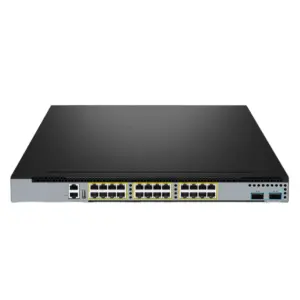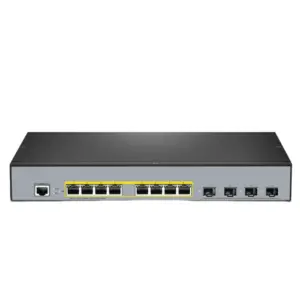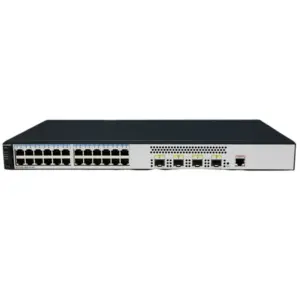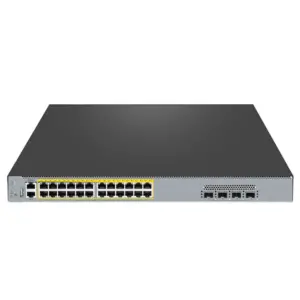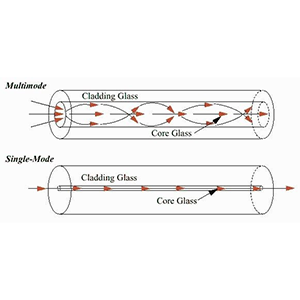I am pleased to introduce you to the Gigabit switch, a device used for high-speed data exchange, mainly used in local area networks (LAN). Gigabit switches have fast transmission rates and multiple Gigabit Ethernet ports, which can meet the needs of high-speed connections and fast data transmission in enterprise and home networks.
The working principle of Gigabit switches is based on technologies such as forwarding tables, MAC address learning and forwarding mechanisms. It can forward data packets to the target device based on the MAC address to achieve efficient data exchange. The transmission rate reaches 1 gigabit per second (Gbps), which is faster than traditional 100 megabit per second (Mbps) switches. It also has a large number of ports, high throughput, and low forwarding delay to meet the needs of high-speed data Transmission and low-latency network environment requirements.
Introduction to Gigabit switches
Definition and background:
A Gigabit switch is a high-speed data switching device used in local area networks (LANs). It provides faster data transfer rates than traditional Fast Ethernet switches, reaching speeds of 1 Gbps (gigabits per second). The emergence of Gigabit switches is mainly to meet the demand for higher bandwidth requirements in modern network environments.
In the past, Fast Ethernet switches (100 Mbps transmission rate) were the most common LAN switching equipment. However, with the continuous increase in network applications and the transmission of large amounts of data, higher transmission rates are required to meet the growing data demand. The introduction of Gigabit switches fills the transmission rate gap, allowing the network to transmit data faster.
working principle:
The working principle of Gigabit switches is based on the following key mechanisms:
-
Forwarding Table: The switch maintains a forwarding table that records the MAC address of the device associated with each port. By examining the packet’s destination MAC address, the switch can determine which port the packet should be sent to based on the forwarding table.
-
MAC Address Learning: When the switch receives a data packet, it records the correspondence between the source MAC address and the source port and stores it in the forwarding table. In this way, the switch can learn the location of each device on the network and be able to forward the packet based on its destination MAC address.
-
Forwarding: Once the switch learns the destination MAC address of the data packet and the corresponding port, it will use this information to forward the data packet to the correct port. This forwarding method is called store-and-forward (Store-and-Forward), in which the switch receives the entire packet and performs error checking before forwarding it out.
-
Collision Avoidance: Gigabit switches support full-duplex communication, which means that it can send and receive at the same time, avoiding the collision problem in traditional half-duplex communication. Full-duplex communication can provide higher bandwidth utilization and lower transmission delay.
Through these working principles, Gigabit switches can achieve high-speed data forwarding and traffic management, providing faster LAN transmission rates and more reliable data exchange. It is widely used in modern networks to meet the needs for high bandwidth and high performance.
Features and performance of Gigabit switches
Transmission rate:
Gigabit switches have a transfer rate of 1 gigabits per second (Gbps), which is one of their most notable features. Compared with traditional 100 megabits per second (Mbps) switches, Gigabit switches provide faster data transmission speeds and can meet the demand for higher bandwidth in modern network environments. This high-speed transmission capability makes the transmission of large-capacity data more efficient and faster.
Number of ports:
Gigabit switches usually provide multiple Gigabit Ethernet ports, and the number can vary depending on the model and specifications of the switch. Typical Gigabit switches can have 8, 16, 24, 48 ports, or even more. This number of ports can support the simultaneous connection of multiple devices and provide high-bandwidth data exchange.
Throughput and forwarding latency:
The throughput and forwarding delay of a Gigabit switch are important indicators for evaluating its performance.
Throughput refers to the amount of data that the switch can process per unit time. Gigabit switches have high throughput, can support simultaneous transmission of large amounts of data, and provide efficient data exchange capabilities.
Forwarding Latency refers to the time delay for the switch to process data packets. Gigabit switches use hardware forwarding and generally have lower forwarding delays. Lower latency is very important for real-time applications and scenarios that require high network latency, such as real-time audio and video communication, online games, etc.
In addition to transmission rate, port number, throughput and forwarding delay, Gigabit switches also have some other features and performance advantages, such as:
- VLAN support: Gigabit switches usually support virtual LAN (VLAN) technology, which can divide a LAN into multiple logical networks, providing better security and management flexibility.
- QoS support: Switches usually support Quality of Service (QoS) functions, which can prioritize data flows and control traffic to ensure priority transmission and bandwidth guarantee for key applications.
- Reliability and redundancy: Some advanced Gigabit switches support redundant links and hot backup functions to ensure high availability and fault recovery capabilities of the network.
Application areas of Gigabit switches
Corporate network:
Gigabit switches are widely used in enterprise networks and are mainly used in the following aspects:
-
Office network connection: Gigabit switches can be used to connect computers, printers, IP phones and other equipment in the office, providing high-speed data transmission and stable network connections.
-
Data center: In the data centers of large enterprises, Gigabit switches are used to connect servers, storage devices and network devices, support high-density data transmission and processing, and meet the high-performance requirements of large-scale data centers.
-
Inter-server communication: In an enterprise network, rapid data exchange and communication are required between multiple servers. Gigabit switches provide high-bandwidth and low-latency connections, supporting fast data transmission between servers and ensuring efficient business processes.
Home network:
Gigabit switches also have some common applications in home networks:
-
High-speed Internet access: With the popularization of broadband Internet, home users’ demand for high-speed Internet access continues to grow. Using Gigabit switches can provide faster network connection speeds, allowing home users to enjoy services such as faster web browsing, video streaming, and online gaming.
-
Fast data transmission between multiple devices: There are usually multiple devices in modern families that require data sharing and transmission, such as computers, smartphones, smart TVs, network storage devices, etc. By using Gigabit switches, high-speed internal communications can be established in the home network to achieve fast data transmission and sharing between devices.
It should be noted that for home networks, large port counts and advanced features are generally not required. Therefore, some small Gigabit switch products are very suitable for use in home networks. They usually have fewer ports and provide simple and stable network connections.
How to manage and configure Gigabit switches
Network topology:
When configuring a Gigabit switch, you can consider the following common network topology configurations:
-
Star Topology: This is the most common network topology in which every device is connected to a central switch or router. In a star topology, communications between all devices are forwarded through switches, which serve as connections and centralized management.
-
Stacking: Some Gigabit switches support the stacking function, which can stack multiple switches together to form a logical single device. Through stacking, the number of ports and bandwidth can be expanded while simplifying management. In a stack configuration, multiple switches are connected to each other through stack links to form a high-availability and high-bandwidth network.
-
Link aggregation: Gigabit switches usually support the link aggregation function, also known as port binding or port aggregation. Link aggregation allows multiple physical ports to be bonded into a logical high-bandwidth connection, providing greater bandwidth and redundancy. Through link aggregation, you can increase the reliability and performance of your connection.
VLAN and QoS:
Gigabit switches typically support VLAN and QoS features for network segmentation and traffic management.
-
VLAN (Virtual LAN): VLAN allows a physical network to be divided into multiple logically independent virtual networks to achieve logical isolation and security. Through VLAN, different departments, user groups or applications can be divided into different virtual networks, and communication between them is restricted. Configuring VLAN requires defining the VLAN ID, port membership, and interconnection relationships between VLANs.
-
QoS (Quality of Service): The QoS function allows priority classification and management of different types of traffic to ensure priority transmission and bandwidth guarantee for key applications. By configuring QoS, data flows can be prioritized, bandwidth limited, and traffic scheduled. QoS can be applied to specific VLANs, ports or applications to meet different traffic needs and service level requirements.
When managing and configuring Gigabit switches, you can usually do this in the following ways:
-
Web interface: Many Gigabit switches provide a Web-based graphical user interface (GUI) that allows easy management and configuration of the switch through a browser. Through the web interface, administrators can access various settings, status, and statistics and make necessary changes and adjustments.
-
Command line interface (CLI): Some Gigabit switches also provide a text-based command line interface (CLI), which allows you to interact directly with the switch through the command line terminal. The CLI usually provides more advanced configuration options and flexibility and is suitable for administrators who are familiar with command line operations.
-
Remote management: Gigabit switches usually support remote management protocols, such as SSH (Secure Shell) and Telnet, allowing administrators to remotely connect to the switch through the network for management and configuration. Remote management allows administrators to manage the switch from a remote location or a central management system, improving management convenience and efficiency.
It should be noted that the management and configuration methods of Gigabit switches may vary depending on the manufacturer and model. It is recommended to refer to the user manual and documentation of the switch to learn the specific management and configuration methods.
Advantages and considerations of Gigabit switches
High-speed data transmission:
Gigabit switches have the following advantages in high-speed data transmission:
-
Faster network connection: Gigabit switch supports Gigabit Ethernet rate, providing higher data transmission speed. Compared with traditional Fast Ethernet, Gigabit Ethernet provides 10 times the bandwidth, making data transmission in the network faster and more efficient.
-
Low transmission delay: Gigabit switches have low transmission delay, that is, the time required for data to be transmitted from one port to another is very short. Low latency is important for real-time applications and tasks that require high network response speed, such as video conferencing, real-time audio, and online gaming.
Network expansion and bandwidth requirements:
Gigabit switches have the following roles in network expansion and meeting bandwidth needs:
-
Network expansion: As a business or home network grows, more devices and users need to be connected. Gigabit switches provide a larger number of ports and can support the connection of more devices. In addition, some Gigabit switches support stacking functions, which can stack multiple switches together to expand network scale and bandwidth capacity.
-
Bandwidth demand: With the increase in network applications and services, the demand for bandwidth is also increasing. Gigabit switches provide higher bandwidth to meet the transmission needs of large amounts of data. It can handle larger amounts of data, support high-load applications and complex business processes, and ensure network stability and performance.
-
Future development: Considering the growing network needs and technological development, choosing Gigabit switches is a strategy for future expansion. Even if the devices and applications in the current network fail to take full advantage of Gigabit speeds, Gigabit switches provide sufficient bandwidth reserves to accommodate higher bandwidth demands that may arise in the future.
Factors to consider:
When selecting and deploying Gigabit switches, you also need to consider the following factors:
-
Price: Gigabit switches usually have a higher cost than 100M Ethernet switches. Therefore, the balance between performance and cost needs to be considered, considering budget constraints and actual needs.
-
Network device support: Gigabit switches provide the advantage of high-speed connections, but to give full play to their performance, other network devices (such as servers, computers, routers) also need to support Gigabit Ethernet interfaces. Ensure that all components in the network are compatible and adaptable to the speed of the Gigabit switch.
-
Management and configuration: Gigabit switches usually provide more configuration options and management functions, requiring certain network knowledge and management skills to correctly configure and maintain the switch. Considering the complexity of management, you can choose switch products with ease of use and friendly management interface.
Summarize:
As a high-speed data switching device, Gigabit switches have fast transmission rates and multiple Gigabit Ethernet ports, providing high-speed connections and fast data transmission capabilities for enterprise and home networks.
Through network topology configuration, VLAN and QoS function management and configuration, Gigabit switches provide flexible network configuration solutions. Its advantages lie in high-speed data transmission and adaptability to growing network expansion and bandwidth requirements. Choose Gigabit switches, you can get faster network connections and better network experience.
- What is the difference between a normal switch and a gigabit switch?
- How does a 24 port gigabit switch work?
- Why use a gigabit switch?
- Is a gigabit switch a PoE switch?
- What is the difference between 1gb and 2.5gb switch?
- Is 2.5 g switch worth it?
- Do I need a 10gb switch?

